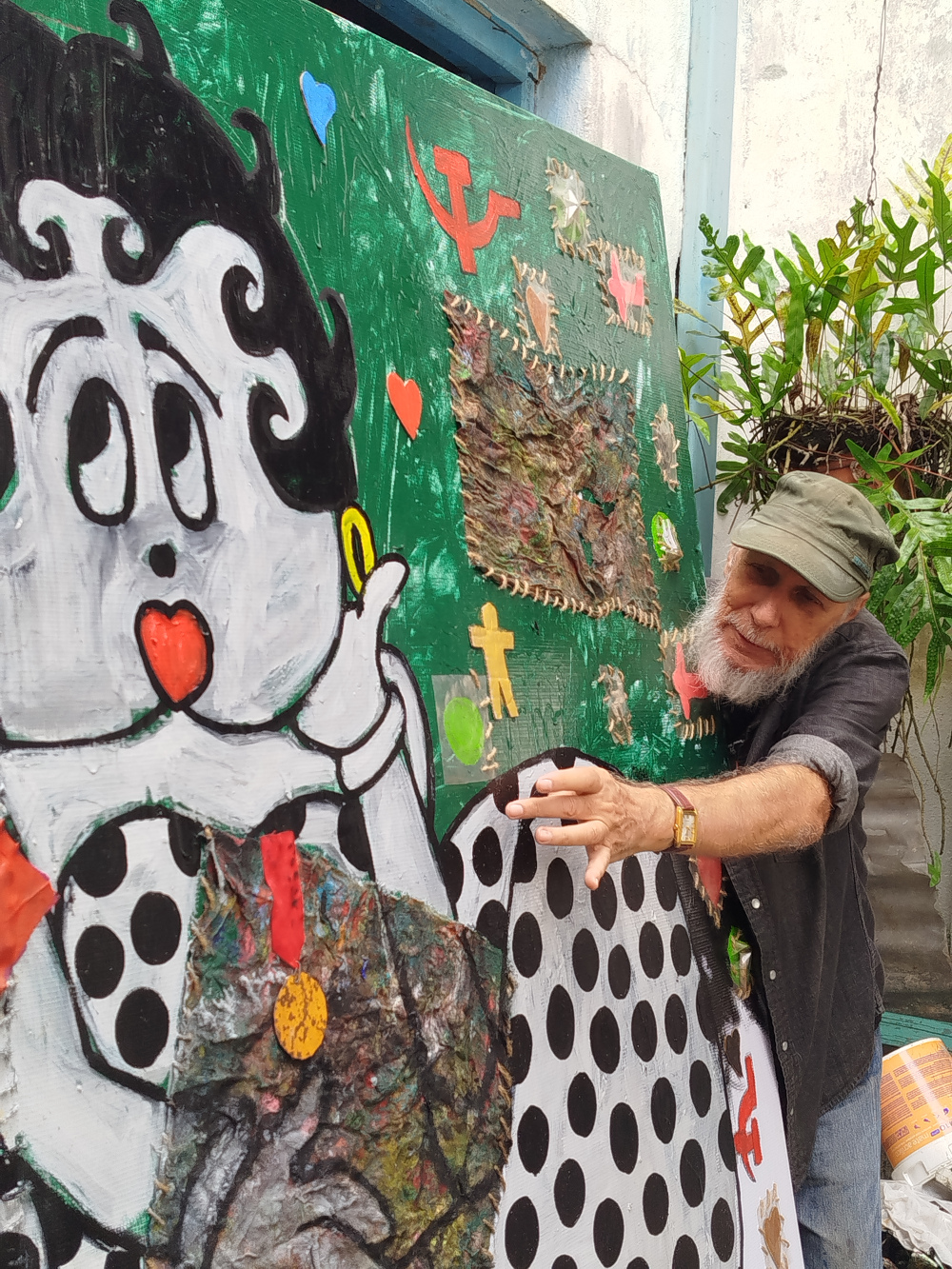CAMAGÜEY.-Joel Jover Llenderroso, one of the most influential artists in Cuban art, returns to the Havana Biennial, this time as part of the exhibition honoring the 40th anniversary of the event. The exhibition, curated by Nelson Herrera Ysla, brings together 26 artists at the Cultural Station Línea and 18, a space that celebrates the careers of those who have marked the history of the Biennial.
Jover is participating with six large-scale works from his Canto a mí mismo series, created in mixed media on nylon. The series was first shown in Camagüey in February 2022 as a collateral exhibit of the 32nd Salon of the City. Back then, he didn’t display his works in a conventional space but rather in the El Orbe store, on the commercial Maceo street.
We recently visited his studio under the pretext of the Biennial. I felt like I was entering a parallel universe, where brushes, nylon, and now a large sewing needle reveal his personal story. There he was, working on a monumental piece, stitching together fragments of his past.
He was working on a new series in which he evoked the animated characters he saw in his childhood when television only broadcast in black and white. Betty Boop, among other characters, appears as another symbol in this mosaic full of memories and icons from a whole life.
He paused his sewing ritual to discuss the second Havana Biennial in 1986 when he was selected among 50 artists. Back then, he lived in Lugareño, a small village surrounded by sugarcane fields.
There he painted the works that took him to the Biennial, isolated from the urban art circuits. So much so that the renowned Raúl Martínez, driven by curiosity, visited the village to ensure that Jover was truly working in that rural landscape.
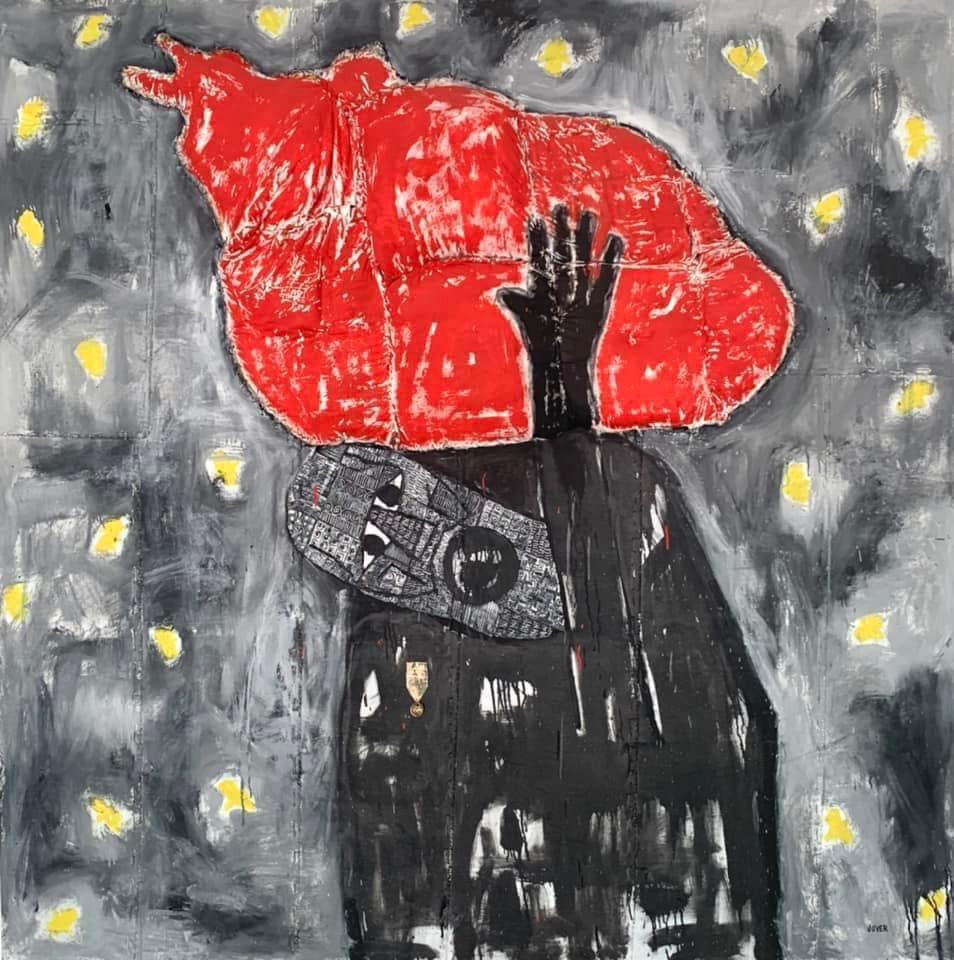 Canto a mí mismo
Canto a mí mismo
A HISTORICAL LINK WITH THE BIENNIAL
Joel recalls his early participation in the Biennial, specifically in the second and fourth editions when the event was based at the National Museum of Fine Arts. Although the format of the Biennial has changed over the years, spreading across multiple spaces, Jover continued to take part in collateral exhibitions. “After the fourth, everything began to change, but I was in almost all the others,” he explains.
The artist mentions that the exhibition for the 40th anniversary brings together creators from different generations, from established figures like Roberto Fabelo and Manuel Mendive to younger artists whom he doesn’t yet know. The exhibition opened on November 18, and he couldn’t hide his excitement to be part of this celebration.
His inclusion in this central exhibition holds special significance. “I always say my carnival is over,” he says humbly. “I’m from past generations, and I’m not at the scene center. I’m an artist who works for the love of art. Never better said: for the love of art.”
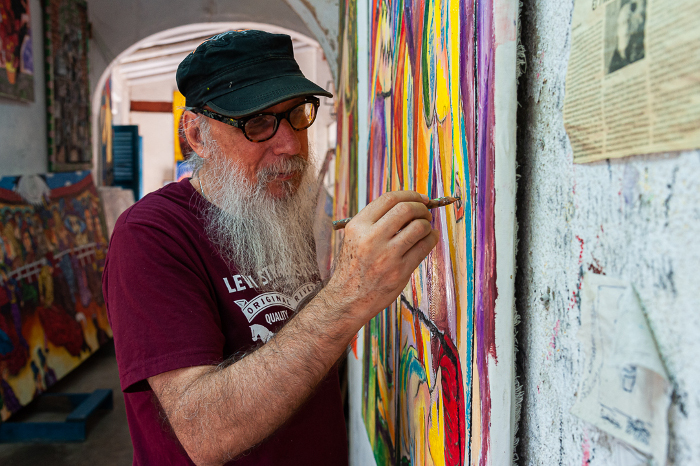
ART FROM THE PERIPHERY
The conversation becomes personal when Jover recalls his beginnings. During the second Biennial, he lived at the Central Lugareño and worked in Minas, in conditions that many would consider unfavorable for an artist. He humorously recounts how painter Raúl Martínez was sent to check if his works deserved to be in the Biennial. “Raúl came to find me in Minas, but I had to explain to him that I was 12 kilometers away, in the middle of sugarcane fields,” he laughs. “In the end, he told me, ‘If your works weren’t good, you’d still go to the Biennial, because painting where you’re painting, nobody else does that.’”
For Jover, Cuban art should not be limited to what happens in Havana. “Sometimes it seems like Cuban art is confined to the capital. This may be the syndrome of the country boy, but no, it’s true. But I say it’s what’s made from the tip of Maisí to Cabo de San Antonio, it could be more or less contemporary, more or less good, that’s a Cuban art problem,” he says.
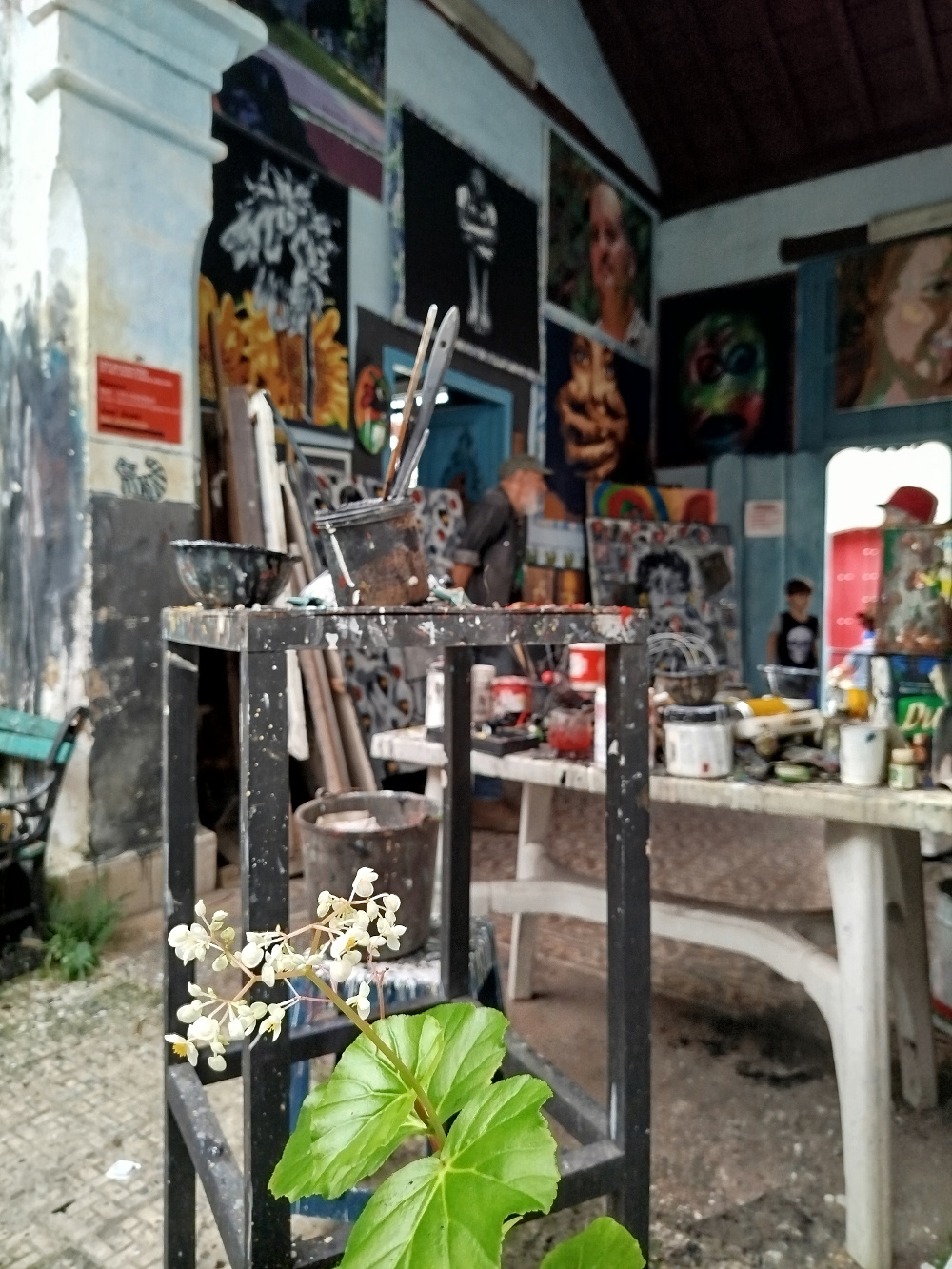
AMID LEAKS AND ROT
Today, in his Camagüey studio, far from the comforts of the larger studios of other artists, he continues to create. The humidity and leaks have witnessed his struggle to preserve his works, many of which were lost due to rot.
The artist reflects on the conditions in which he works. His studio, located in an old building in Camagüey, is a modest but vital space for his creativity. “People say it’s dirty, disorganized, but this is a studio, not an art gallery,” he comments. Despite the limitations—humidity, leaks, and lack of resources—Jover continues to create.
Many of his old paintings have succumbed to deterioration, but Joel accepts it philosophically. “I’m going to die, I’m going to rot too. So, we shouldn’t worry too much about transcendence. I want to have fun now, which is what I’ve always done.”
This time, working with nylon, he hopes that time will be more forgiving.
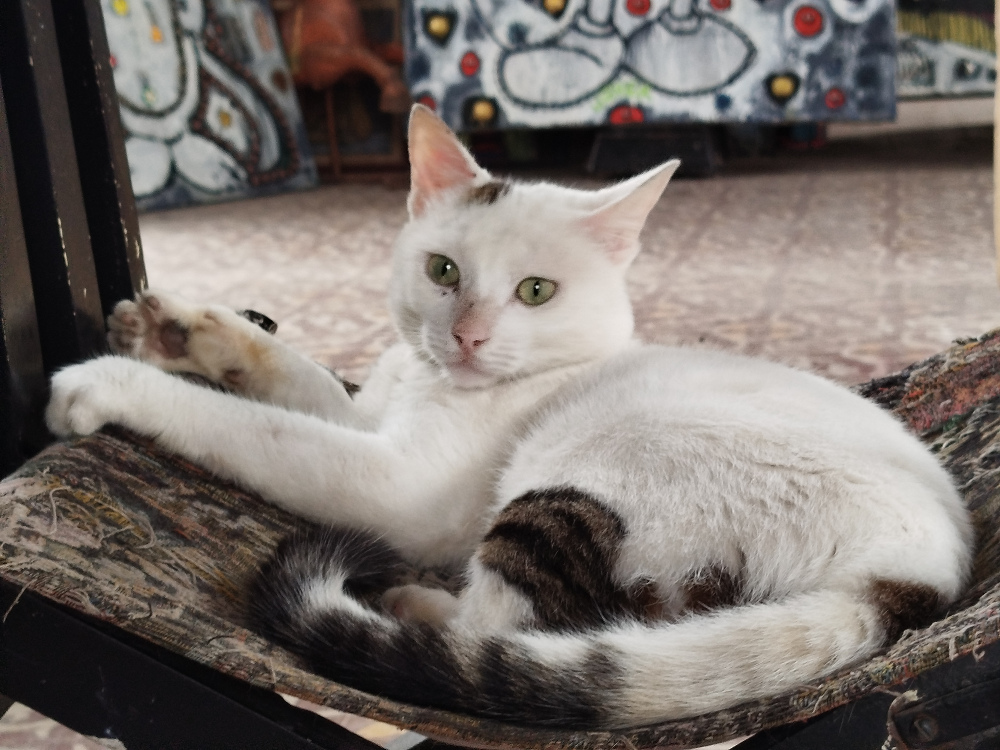
CURRENT EXPLORATIONS AND PARADIGMS
In recent years, Jover has expanded his creative horizon by incorporating techniques like sewing, an art he learned as a child thanks to his mother. “I have fun sewing. At this age, if everything isn’t allowed, I allow myself to do it,” he says with a smile.
Jover learned to sew by mending fishermen’s nets and embroidering checked shirts in his youth. He has now brought this skill to the center of his creative process. Every stitch in his works is like an echo of the past shaping his present.
“My mother was a seamstress, and my father, you know, we lived at the port of Tarafa. I first learned to sew fishing nets, meaning mending the nets with the needle. Then I learned to embroider. There were checkered shirts, and I wanted them to have little things, my mother marked them for me and said this is like this and that, the ‘caneva’ stitch. I made my shirts and put on buttons. I’m kind of remembering,” he emphasizes.
He attributes his current work to the current economic situation, where “there’s no place to tie the goat, you have to invent because I can’t stop working, that’s all I know how to do. Although I claim not to have another trade, I say: ‘I could start embroidering ‘caneva’, but it’s no longer used.’”
His new series explores icons and paradigms, inspired by the cartoons from his childhood. “I want to give them a special meaning. They are my idols, my paradigms. That’s the direction I want to take to talk about what it means to have references.”
A SHORT BUT SIGNIFICANT JOURNEY
Jover does not plan to stay in Havana for long, but he will attend the exhibition’s opening. “I’m going there and back, like on a safari. Stars shouldn’t show themselves too much,” he jokes.
At 71, he talks about his career and his decision to stay in Camagüey rather than move to the capital or abroad. “I had opportunities, but I never wanted to leave. What I need is space, peace, and materials to work. Here I feel good.”
With more than five decades of career, he continues to create with the passion that drove him at 17. His return to the Biennial is not only a recognition of his work but also a testimony to his unwavering commitment to art.
Jover shares his vision with the same sincerity and authenticity that characterizes both his work and his personality. “I don’t need to be in the capital,” he begins, marking both a physical and ideological distance. He reflects on the uniformity he perceives in the artistic circles of large cities: “Sometimes I get the impression that in the capital, there’s a collective contagion regarding styles; people start to look too similar. Before, I’d send my works to Havana without thinking, whether they were accepted or not, it didn’t matter. Now, however, I’m filled with a certain fear. I don’t know how my pieces will look amid that avalanche of artists, many of whom I don’t even know what they do. I know that what predominates there is what they call contemporary art, but I don’t consider myself part of that. I’m an artist, but not a contemporary artist. Contemporary art has its characteristics, and even though some say it’s not really art but more of a style, I prefer not to enter that mix.”
Despite his reservations, there is no disdain in his words, only an honest confrontation with his own fears and limitations: “I feel that fear, but then I think: so what? I’m going to go to the opening, I’ll be congratulated, some sincerely and others not, and then I’ll go back to the place where I really feel good. Here, people like me, most of them.”
Jover not only offers a portrait of his perception of the artistic world but also of himself: a creator deeply rooted in his identity and the human connections that sustain him. His reflection transcends art and becomes a statement on authenticity, belonging, and the search for meaning in a space that defines him beyond labels and styles.
His art is his vice, his play, and his life, although sometimes he wonders if what he does is really art. He paints to have fun, and although that may unsettle some, Joel Jover, in his



